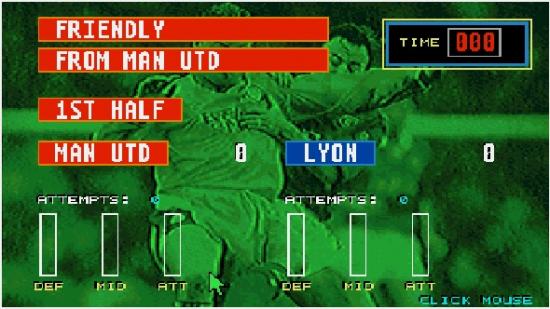The year is 1992. The Atari 2600 is discontinued a full 15 years after its initial release. Disneyland Paris opens its doors to the public. Cartoon Network launches. John Boyega is born (yeah, that one made you feel old). Isaac Asimov dies. Disney’s Aladdin grosses over half a billion dollars at the box office. Nirvana’s Nevermind hits no.1 in the US Billboard charts.
Looking for a future prospect? Check out these Football Manager 2017 wonderkids.
And a plucky young upstart in the field of football management simulation games emerges in the form of Championship Manager, ready to take on the Tracksuit Managers and Premier Managers of the world. Eschewing the graphical flourishes of its rivals – no offices with Venetian blinds here – it instead favours cold, hard statistics.
25 years later, the series celebrates a milestone in 2017. Football Manager (the series was renamed following a split between Sports Interactive and long-time publishers Eidos) is pretty much THE only footy management game in town and, truth be told, it’s been that way for a good few years now. Premier Manager soldiered on for a few years before being steamrolled by Sports Interactive’s juggernaut; LMA Manager offered a short-lived alternative for console owners; Championship Manager became a completely different title, eventually living on through mobile releases only.
However, the groundwork for the franchise’s huge and continued success was laid in its most formative period from ‘92 to 2004. So, join me as I take a look back at the Championship Manager years.
Championship Manager
Published by Domark (ask your dad), written in BASIC (ask your dad) by the Collyer brothers and featuring no real-life players, Championship Manager stood out from the crowd with an eye-catching match engine and the introduction of the average rating to the genre, meaning that you could now track the performances of your players over several games. Whilst reception was muted, you can see the foundations were already in place.
Barnet, champions of England
Everybody loves taking control of their favourite team in any football game, but the real achievement in the Championship/Football Manager series is to be had by “running the table” – taking a team from the depths of the bottom league to the heights of the top league. Such a challenge represents my earliest and, in some ways, fondest memory of the series. Lowly Barnet FC had only been in the Football League for a year when I took the reins. Regularly drawing crowds in the hundreds, rather than the thousands, the challenge couldn’t have been much more difficult, but through tactical nous and prudent use of my real-life football knowledge to pick up some bargains (I had a lot more spare time on my hands back then), I was in the Premier League within six seasons. Two seasons later, and just eight after playing Hereford United in front of 400 people, I wrapped up the Premier League title, and my love affair with the series was set in stone.
Championship Manager 93/94
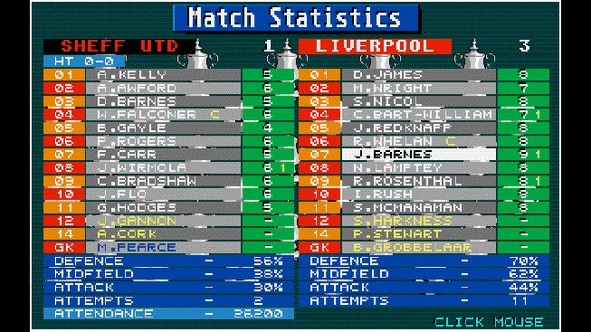
Following the template of its predecessor, 93/94 saw a slew of iterative features added (including injury time…more on that later) and, more importantly, real-life players replacing the original’s fictional generated ones. This was what set Championship Manager above its rivals and ensured it quickly became the management sim of choice. This was also the first game in the series to be developed under the Sports Interactive studio name.
The formation
Ask any player of the series in recent years about their favourite formations, and you’ll receive a plethora of answers covering variations of your standards. You know, your 4-4-2 with a holding midfielder, your 4-3-3 with a false 9, your 5-3-2 with a sweeper. But ask me as someone who played the series in its earliest days and there’s only one formation. The formation. No full-backs. No wide midfielders. No wingers. A sweeper and two centre-backs. Three central midfielders and an attacking midfielder. Three centre forwards. I know, I know…it sounds utterly crazy, but it was absolutely unbeatable. It wasn’t uncommon to see scorelines of 8-0, 9-0 and even occasionally 10-0, as I dominated every game and every team I came up against. Sure, it got pretty dull, pretty quickly, but it was always fun to break it out every now and then and watch your mates’ faces as you rained shock and awe down upon them.
Championship Manager Italia
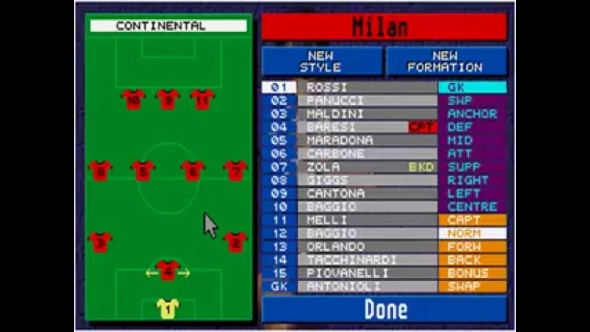
Essentially a reskin of 93/94, Italia came around at a time when, thanks to Channel 4 coverage of Serie A, British interest in Italian football was at an all-time high. Therefore, the first opportunity to manage the likes of Roberto Baggio, Franco Baresi and Paolo Maldini ensured that Italia was guaranteed to be a big seller.
The last minute winner
I can’t even claim this story as my own, but I witnessed it. I was there. I would pop round to a friend’s house every week to play his copy of Italia and, whilst I could hold my own over a league season, he would always find a way to sneak over the finishing line first. But when it came to Europe, we both struggled…until the season. Having serenely sailed through to the semi-finals of the Champions League as Juventus behind the goals of Roberto Baggio and Ryan Giggs, my journey was cruelly ended in a 5-4 aggregate defeat when I came up against my friend’s formidable AC Milan side. And so it was that I took a seat to watch him take on Bayern Munich in the first Champions League final that either of us had made. It did not make for pleasant viewing in the first half, as he quickly fell 2-0 down with Lothar Matthaus pulling the strings. But the second half? Well, that would become the stuff of legend. An early goal from Gianluigi Lentini gave him hope. A Jean-Pierre Papin header gave him belief. And as Roberto Donadoni slid home the winner in the 93rd minute (sweet, sweet injury time), even I found it impossible not to leap out of my seat and punch the air…
…no, you shut up.
Championship Manager 2
OK, I have a confession at this point – I basically didn’t play Championship Manager from around 1995 to 2001. I know, I know – but being in my late teens/early 20s as I was, I decided to adopt some of the social norms and give the whole “social life” thing a try. However, I’m nothing if not diligent so here’s a potted history of what I missed:
In 1995 Championship Manager 2 was released. Whilst many of the gameplay elements remained the same, the best addition (and, by “best”, i mean “absolute worst”) was the optional audio commentary provided by Clive “I’ll find a way to mention 1966, regardless of who’s playing” Tyldesley.
Championship Manager 96/97
Champ Man 96/97 hit the market primarily, like many games in the series, as an iterative update. However, 96/97 also deserves mention as the first game in the series to feature playable leagues in more than one country, with Scotland and Italy joining the fray.
Championship Manager 97/98
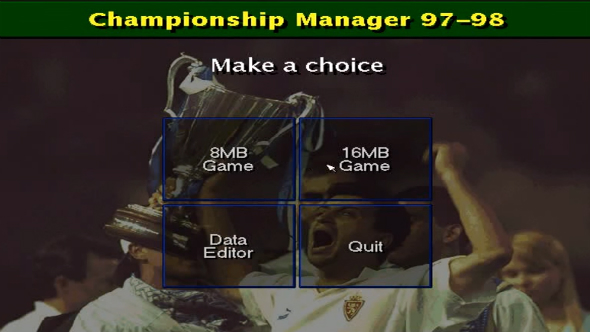
By now, SI were really hitting their stride and Championship Manager 97/98 – the last game of the Championship Manager 2 series – featured a total of nine countries with playable leagues (Belgium, Holland, France, Germany, Portugal and Spain now added) and, more importantly, allowed for more than one league to run concurrently.
Championship Manager 3
Championship Manager 3 was finally launched to huge anticipation in the spring of 1999. In addition to a UI overhaul, its main new feature was a big one – multiplayer via LAN and internet. Yep, no longer were you just exchanging stories with your mates and hoping they believed you (much like I’m asking you to do by reading this… ahem). Now, you could actually involve your mates in those stories, providing the opportunity to gain those all-important bragging rights.
Championship Manager 00/01
2000: In a real departure from their usual naming convention, SI and Eidos named their latest game… Championship Manager 00/01. As well as the usual incremental improvements across the board, it was the first game in the series to include a full database editor. Want to give Leyton Orient £100m? No problem. Want to turn Egil Ostenstad into the second coming of Pele? Then there’s probably something wrong with you but, sure, you can do that too…
However, one entry in the franchise garnered so much positive praise that I couldn’t keep away any longer. That entry was…
Championship Manager 01/02
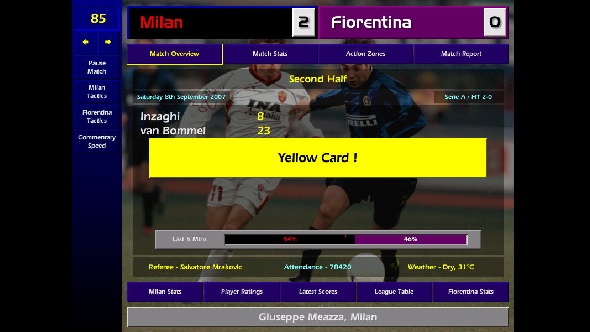
Representing the pinnacle of the series for many (so much so that the game was eventually made available for free, and dedicated souls continue to produce data updates for it to this day – in fact, I’m playing it again now!), 01/02 introduced the EU regulations on the Bosman free transfer system, attribute masking (strategy game fans may know this better as the “fog of war”) and a whole host of other features, players and leagues. For diehard fans of the series though, 01/02 will forever be known for its legends – mention the likes of Maxim Tsigalko, Cherno Samba, Kennedy Bakircioglu and Mark Kerr to them and watch them lose all semblance of composure as they get misty-eyed remembering their former glories.
The free transfer scramble
In addition to being the first game to incorporate the Bosman ruling, Championship Manager 01/02 also featured a veritable feast of players that could be snatched up on free transfers from day one, which led to a number of mad dashes to grab the best players available – Taribo West (Bravery 20, Determination 19, Stamina 19, Strength 20) being a particular favourite – but it was a less-heralded player who became my target of choice. 16-year-old Norwegian striker Morten Rasmussen certainly looked nothing special on paper, and the first time I signed him was with the sole intention of selling him at a modest profit. So, imagine my surprise when he turned into a genuine world beater within three seasons and the first player I seek out in every new save. The best thing about the game is that, if you ask anyone who played it at the time, they all have their own Morten Rasmussens, giving all of them their own “diamond in the rough” stories to bore people with at parties. You lucky, lucky people.
Championship Manager 4
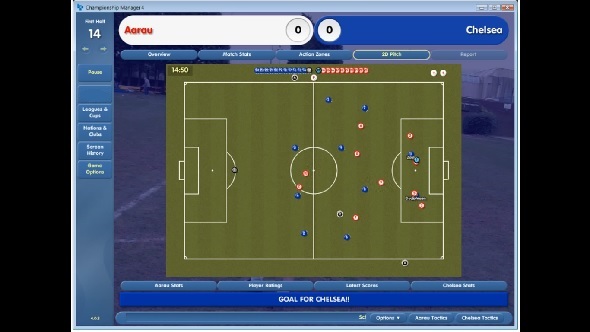
Representing the first full refresh in several years, Championship Manager 4’s biggest selling point was the introduction of a full 2D overhead match engine, adding a whole new layer of tactical information – you could now actually see your full-back being put to the sword by the opposition’s star winger, rather than have a guess based purely on the match rating he had at half-time. It allowed for more on-the-fly tactical decisions to be made and meant that many games – especially against fellow human beings – played out like games of chess with each reaction and tactical switch setting off a chain reaction of moves and counter-moves.
Turns out you can win something with kids
I decided to have some fun with Championship Manager 4. Rather than start from the bottom and work my way through the divisions, which was my normal course of action, I chose Inter Milan and proceeded to spend every single Lira that came my way. Ronaldo (OG, natch) and Thierry Henry formed the most expensive strike partnership I ever formed in a Championship Manager game. Fabio Cannavaro and Rio Ferdinand forged a fearsome defence and Patrick Vieira pulled the strings like a maestro. Yet, for all that, the key to it all was another teenager picked up on free agency. 14-year-old Giampaolo Bellini – who I assumed at the time was a fictional player – had stats that looked too good to be true. It appeared that I’d found my very own Freddy Adu but, unlike the American prodigy, Bellini lived up to his potential at every turn. Worth £25m by the time he turned 16, he was world player of the year by 18, and remains the single best player I’ve ever managed. No matter how many new saves I started, no matter how many different clubs I chose to manage, I never found him again, but I’ll always have Inter Milan.
Championship Manager 03/04
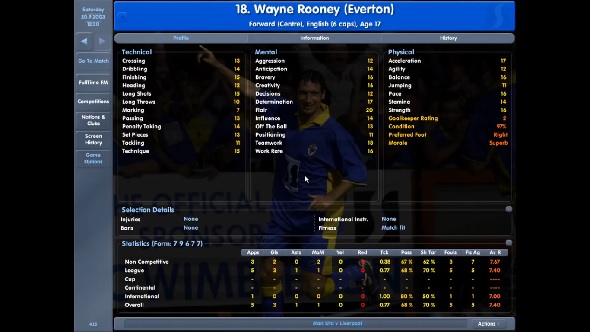
The last Championship Manager produced by Sports Interactive before the infamous split from Eidos, 03/04 was an iterative update for the most part, and represented the last time that I’d devote dozen of hours to any football management game. Featuring 96 fully playable divisions across 42 leagues, 03/04’s big new feature was the ability to use the match engine to watch back previous matches, giving you the chance to effectively live-scout opposition or review the performances of your own players.
100 goals a season
Back in the days of the formation on 93/94, it was no surprise to see my players dominate the scoring charts, with my front four practically guaranteed 20+ goals a season. By 03/04, the AI was sophisticated enough that there wasn’t really any such thing as a “magic bullet” formation any more, and you had to rely on actual skill. This made my achievement in my third season as manager of Rangers all the more remarkable because, as anyone who knows me can tell you, I have very little skill. I won the league that season by 15 points with a goal difference of +90. The reason? My deadly duo of Championship Manager legend, Cherno Samba, and…Peter Lovenkrands. No, I still can’t believe it either. Between the two of them, they racked up 105 GOALS in all competitions (meaning it wasn’t just in the Scottish Premier League, you snarky so-and-sos), propelling me to a domestic treble and career-best Champions League semi-final appearance. Sadly, it was to prove a one-season wonder – their performances attracted the big guns and my Ferrari frontline was gutted. Still though…for one season, I felt like the best manager in the world.
Changing of the guard
2004 was the last time I was able to devote that level of time to a game in the series. In addition to real-life becoming a thing, the switch from Championship Manager with Eidos to Football Manager with Sega brought with it an ever-increasing depth that I’ve never quite been able to wrap my head around. No longer can you just buy players, pick a formation, set it and forget it. Now you have to manage relationships and training schedules and the media and all manner of peripheral activities that seem far too millenial for an old-timer like me. So, to the budding Pep Guardiolas and Jurgen Klopps of the world, I salute you. However, just remember that I and the rest of the grizzled old Walter Smiths and Sir Alexs of the world could still manage you under the table…
